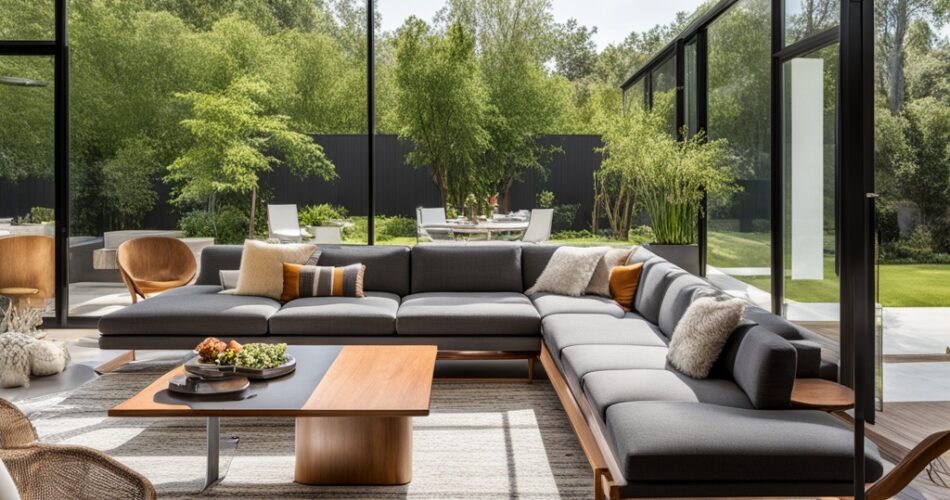The mid-century modern style celebrates simplicity and organic forms. It originated in post-war homes from the 1940s-1960s. The style revolutionized living spaces with open floor plans and large windows blurring indoor-outdoor boundaries.
Mid-mod architecture emphasizes functionality and sculptural beauty. Exposed beams, floor-to-ceiling windows, and natural wood create warmth. The modernist interior aesthetics continue inspiring contemporary spaces.
Discover iconic ranch home aesthetics like open-concept plans, natural materials, and organic forms. Blend atomic design, retro elements, and vintage architecture seamlessly. Focus on Saarinen chairs, geometric patterns, organic shapes, floor-to-ceiling windows, and vibrant 1950s interior style.
Key Takeaways
- Embrace mid-century modern’s simplicity, organic forms, and indoor-outdoor living.
- Add iconic Eames furniture for authenticity and style.
- Use natural wood, fiberglass, and molded plywood for warmth and modernity.
- Prioritize open plans, large windows, and outdoor transitions for nature connectivity.
- Incorporate geometric patterns, bold colors, and sculptural shapes for visual interest.
What is a Mid-Century Modern House?
A mid-century modern house has an open floor plan. It seamlessly blends indoor and outdoor spaces. This is done through expansive windows. There are transitions to patios or yards.
These post-war housing styles were popular from 1945 to 1969. They often have a low-pitched roof or flat roof. There are overhanging eaves and horizontal lines.
Inside, there is post-and-beam construction with exposed beams. There is an absence of ornate details. This creates a minimalist, streamlined aesthetic. Geometric shapes and organic materials like wood are used.
Characteristics of Mid-Century Modern Architecture
Most midcentury modern homes in the U.S. share common elements. These include straight lines, flat roofs, and floor-to-ceiling windows. There are access points to the outdoors.
The minimalist interiors often feature simple furnishings. They have clean lines and a muted color palette. This reflects the 1950s style home’s emphasis on retro design.
Blurring the Line Between Indoor and Outdoor Living
A key characteristic is the emphasis on integrating indoor and outdoor living. This is done through expansive windows, courtyards, and patios. Materials like stone bridge the interior and exterior spaces.
Sliding glass doors and floor-to-ceiling windows create a seamless flow. Entire walls of glass connect the vintage home design to landscaped grounds or pool areas.
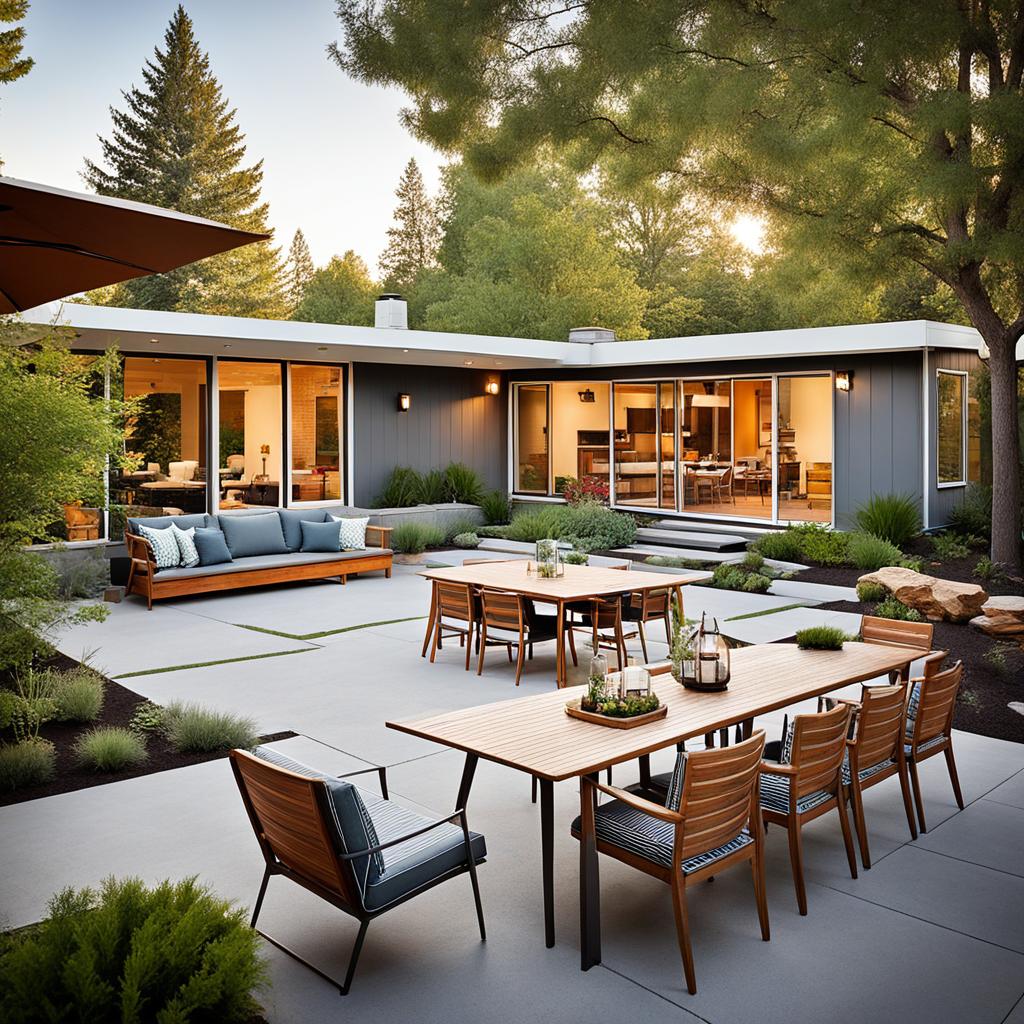
This connection to nature and focus on outdoor living spaces differentiated mid-century homes from previous post-war residential design styles.
| Architectural Style | Time Period | Key Features |
|---|---|---|
| Mid-Century Modern | 1945 – 1969 |
|
Key Elements of Mid-Century Modern Interior Design
Mid-century modern interiors blend natural warmth and innovative materials. This creates an aesthetic celebrating organic forms and functional design. The blend results in rich, layered minimalist living spaces with timeless appeal.
Wood serves as the grounding force in mid-mod architectural design. It lends warmth and texture to sleek lines. Accent walls, built-in shelving, and vintage furnishings showcase natural wood grains.
Elements like exposed brick, stone, and concrete reinforce nature’s connection. Their raw, textural surfaces ground the design. Midcentury architecture also incorporated molded plywood, fiberglass, and plastics. This created an intriguing dialogue between organic and man-made materials.
Bold Colors and Graphic Patterns
While the foundation relies on neutrals, modernist decor comes alive with bold, saturated hues. Drawing from nature, the mid-century color palette features earthy greens, warm yellows, vibrant oranges and reds.
Geometric patterns in fabrics, wallpapers, and rugs add graphic flair. Iconic motifs like starbursts, boomerangs, and atomic shapes celebrate the era’s unique aesthetic. This dynamic color and pattern interplay provides visual interest, balancing overall design simplicity.
Iconic Furniture Designs
Eames-style decor and furnishings by Charles and Ray Eames, Isamu Noguchi, and George Nelson epitomize mid-century modern style. Their sculptural, innovative designs using molded plywood, wire, and fiberglass exemplify “form follows function”.
While minimal in ornamentation, signature pieces make a statement. The Eames Lounge chair, Womb chair, Noguchi coffee table, and Nelson bubble lamps incorporate iconic modernist aesthetics. This elevates overall design, paying homage to groundbreaking creativity.
![]()
mid-century modern house
Mid-century modern architecture marked a shift towards functional yet stylish homes from 1945 to 1969. These retro design homes embraced simplicity, prioritizing open floor plans and expansive windows. Warm, minimalist interiors featured iconic furniture like the Eames lounger.
This architectural design avoided ornate embellishments, opting for clean lines, natural materials, and geometric shapes. Ranch house layouts with split-levels created livable vintage-inspired interiors. From 1950s ranch residences to post-war aesthetics like Eichler homes, these iconic modern residences brought a fresh perspective.
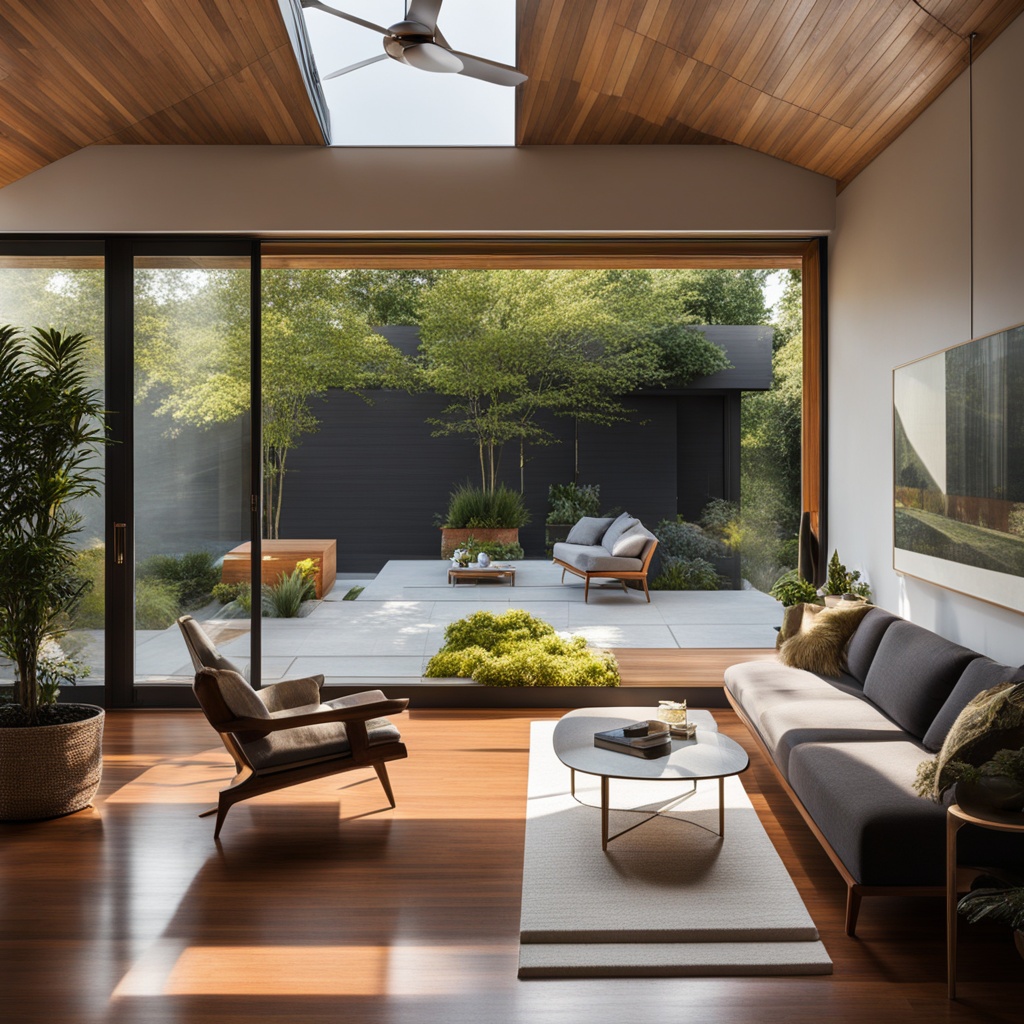
Midcentury modern homes can be identified by their emphasis on simplicity, connection to nature, and use of innovative materials and furnishings that were both beautiful and highly functional.
Rooted in postwar construction techniques, the mid-mod aesthetic continues influencing contemporary design. Its focus on intentional details that enhance livability draws homeowners to the timeless sophistication of these modernist homes.
Designing a Mid-Century Modern Living Room
The mid-century modern living room balances stylish minimalism and cozy livability. Geometric lines and organic forms create an inviting, retro-contemporary space.
Classic Lounge Chairs and Sofas
Iconic mid-century seating celebrates sculptural forms and ergonomic function. The Eames Lounge Chair and Ottoman blend minimalist lines and plush comfort.
Other classics like the Womb Chair and Eames sofa introduce organic curves. Tapered wood legs and low profiles enhance lounging. Fabrics showcase geometric patterns or solids in distinctive color palettes, imparting a mad men aesthetic.
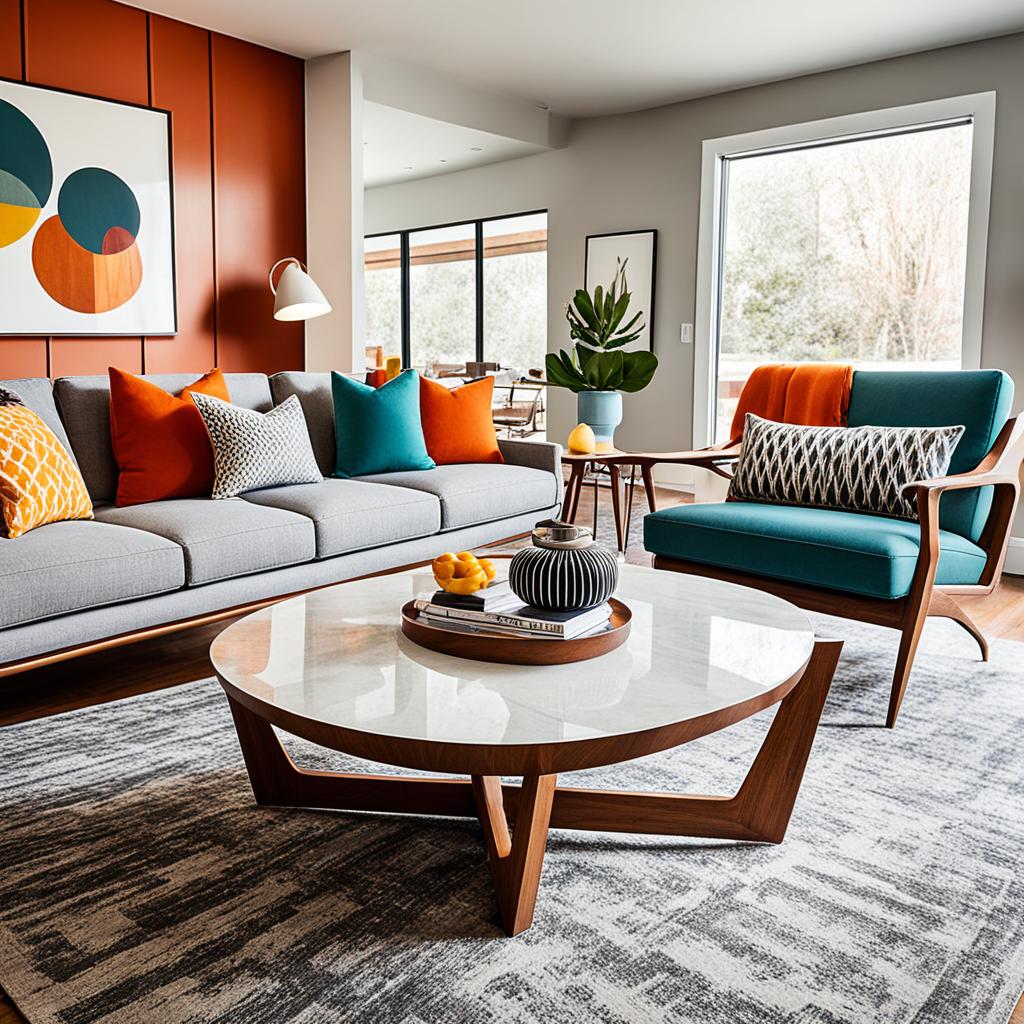
Sculptural Coffee Tables
The Noguchi coffee table embodies artistic yet functional mid-century furnishings. Its sculptural wood base supports a freeform glass top, transforming it into art and a surface for entertaining.
Other classics feature geometric wood bases with glass or stone tops. These low, leggy designs maximize floor space and visibility, upholding the uncluttered mid-mod aesthetic while embodying post-war design principles.
Geometric Patterns and Textures
Textiles and accessories define mid-century modern living spaces through iconic motifs. Geometric patterns like atomic, starburst, and boomerang appear in area rugs, pillows, and wallpapers, adding retro-futuristic flair.
Rich textures like boucle upholstery, sheepskin throws, and nubby woven fabrics complement sculptural furniture shapes. This graphic prints and varied textures interplay creates visual depth and interest within minimalist frameworks.
Organic forms and natural materials lend warmth and authenticity.
| Design Element | Percentage Representation |
|---|---|
| Rectangular and square furniture shapes | 60% |
| Rounded shapes (sheepskins, captain chairs, table decor) | 40% |
| Warm undertones with pops of green and blue | Color Palette |
| Vintage furniture pieces | 70% |
| Mix of organic and geometric shapes | 50% |
| Warm color palette (dark wood, earth tones) | 60% |
| Integration of indoor and outdoor elements | 30% |
| Blend of contemporary artwork and vintage furniture | 40% |
| Prominent use of marble or quartzite | 20% |
| Seamless flow between eras (mid-century and modern) | 25% |
Creating a Mid-Century Modern Kitchen
The mid-century modern kitchen embraces simplicity and functionality. Natural materials like wood blend seamlessly with innovative techniques. These spaces typically have open layouts with large windows. Abundant natural light connects indoor and outdoor areas.
Sleek Cabinets and Countertops
Mid-century kitchens showcase sleek, slab cabinetry without ornamentation. Warm wood-tones like oak, birch, and walnut are common. Two-tone combinations of pale and dark hues add interest while maintaining minimalism. Open shelving displays colorful vintage dishware, nodding to vibrant accents.
Countertops may feature durable laminates, polished concrete, or sleek stones. Clean lines and horizontal orientation define the style.
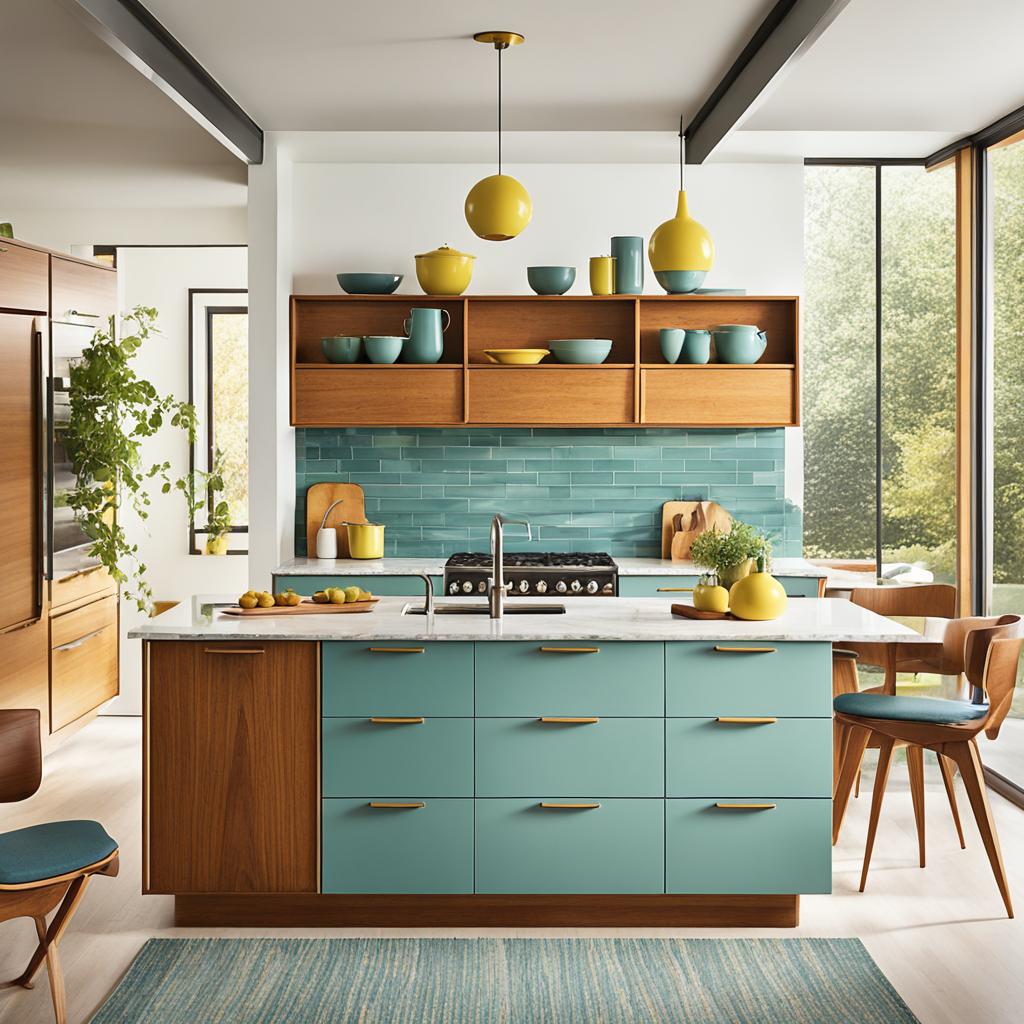
Iconic Dining Sets
For eat-in kitchens, invest in iconic mid-century dining sets. Eames molded fiberglass chairs with Saarinen tulip tables embody innovation. Nelson bubble lamps provide iconic lighting. Walnut credenzas warm the space.
Bright accent colors in dishes, linens, or rugs continue the playful spirit.
Statement Lighting Fixtures
Lighting was integral to mid-century design using new materials. Look for overhead fixtures like Nelson pendants or starburst chandeliers. The Arco lamp’s curved stem balances form and function.
Include decorative ceramic or wood table lamps for workspaces. Lighting’s starring role derives from furniture as functional art.
| Brand | Years of Experience | Specialization |
|---|---|---|
| Deslaurier Custom Cabinets | Over 40 years | Fully customized design services for mid-century modern kitchens |
| Wood & Wire | N/A | Bespoke plywood kitchens and furniture designed and manufactured in the UK, with a compilation of 100’s of mid-century kitchen designs and ideas |
While muted tones and minimal clutter are common, pops of bold colors add interest. Teak paneling with palm green and pale pink creates warmth.
Graceful curves in cabinet handles are key, while clumsy hardware should be avoided.
Modernized mid-century kitchens retain key elements like wood, natural materials, geometrical lighting, and picture windows while blending with contemporary aesthetics.
Bringing Mid-Century Style to the Bedroom
The mid-century modern bedroom exudes timeless allure. It blends vintage-inspired beds, dressers with warm wood tones and organic shapes. Solid wood platform beds epitomize post-war residential design.
These beds have low profiles and clean lines. They were designed by George Nelson or Florence Knoll. The beds can be complemented with slatted or sculpted headboards.
The headboards are in blonde woods or vivid lacquer colors. They add retro panache to mid-mod architecture.
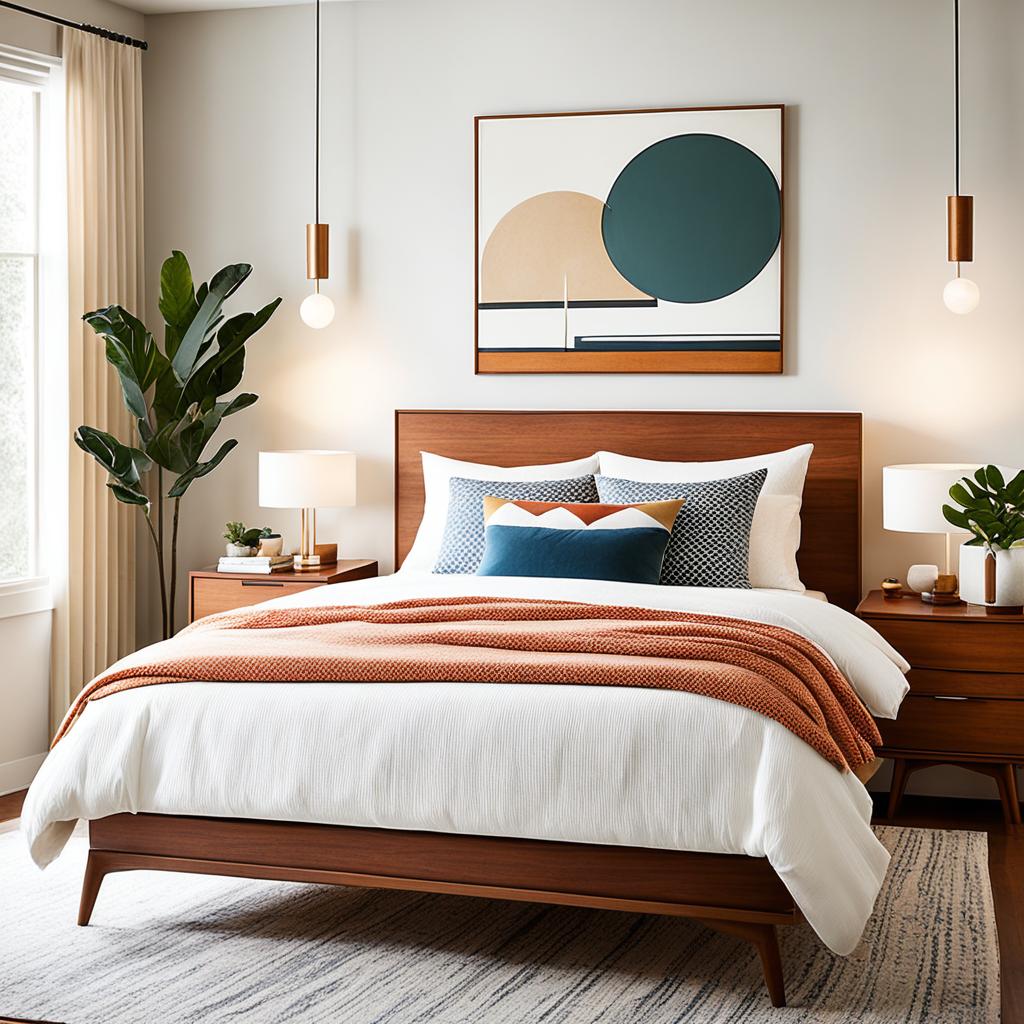
Dressers in mid-century style continue atomic era aesthetics. They have walnut or oak cases raised on angled legs. The dressers feature minimal hardware with geometric motifs.
Accessories reference period styles like Atomic starburst wall clocks. Ceramic lamps with hourglass curves complete vintage interior styling.
Warm Wood Tones and Organic Shapes
Mid-century bedroom designs maintain a streamlined modern look. They incorporate warmth through wood tones and organic nature-inspired forms. Iconic furnishings, vertical wood paneling create textural, earthy contrast.
Exposed beams, brick walls, plush wool rugs add contrast. Sleek, sculpted lines balance modernist decor. Subtle patterns in bedding, window treatments add graphic punch.
Curved accent pieces counter linearity. They create a harmonious mid-20th century, Danish modern blend.
Vintage-Inspired Beds and Dressers
Vintage-inspired beds, dressers form mid-century modern bedroom foundations. 1950s ranch-style dwellings featured these minimalist, sophisticated pieces. They celebrated clean lines, organic materials.
The platform beds have low-slung profiles. Dresser angled legs embody retro interiors, architectural mid-mod style.
Setting Up a Mid-Century Modern Home Office
Crafting a mid-century modern home office embraces iconic modernist aesthetics. The space should blend eames-style decor, vintage furnishings, and minimalist living spaces. It creates a nostalgic time capsule abode.
Ergonomic and Functional Desk Chairs
The mid-century philosophy marries form and function. Invest in ergonomic chairs like the Eames or Aluminum Group designs. Their molded shells and waterfall seats offer sleek profiles and supportive comfort. This echoes the post-war residential era’s emphasis on purposeful solutions.
Minimalist Desk Designs
Complement iconic seating with a minimalist desk embodying clean, horizontal mid-century lines. Simple plank styles with angled metal hairpin legs or classic pedestal bases offer vintage style and functional workspaces.
Incorporate smart storage like Herman Miller’s modular system with painted steel drawers. This adds a pop of atomic age color.
Complete the setup with a stylized desk lamp showcasing the era’s purposeful forms. This balanced fusion creates an inspiring, productive environment.
| Element | Recommendation |
|---|---|
| Desk Size | Mid-century modern style |
| Monitor Size | 27 inches |
| Ergonomic Mouse | Logitech MX Master 2S in Light Grey |
| Office Plant | Faux plant (average cost: $5) |
| Curtain Color | Natural beige or light tan |
| Rug Size | 5×7 feet |
| Budget Consideration | Finding a comfortable modern office chair |
When assembling your mid-century modern home office, strike the perfect balance between ranch house aesthetic, scandinavian minimalism, and modernist design:
- Source mid-century classic pieces for an authentic vintage style.
- Choose warm wood furniture and light accessories as budget options.
- Mix wood tones to achieve a relaxed, inviting ambiance.
- Position the desk centrally for an optimal open-concept plan.
- Define the desk area with a geometric patterned rug.
- Illuminate the workspace with pendant lights overhead.
- Incorporate wooden materials throughout for cohesive, organic feel.
Incorporating Mid-Century Outdoor Living Spaces
The mid-century modern era blurred indoor and outdoor living spaces. Architectural designs seamlessly integrated homes with natural surroundings.
This emphasis on organic geometric forms and retro-futuristic dwellings extended outdoors. It created a harmonious flow from interiors to exteriors.
Patio Furniture with Clean Lines
Vintage-inspired interiors translated iconic modern furniture’s sleek, low-slung forms outdoors. Slender, streamlined aluminum or wrought iron chairs and loveseats continued architectural details.
Woven cord or colorful molded plastic updated classic wood frames. Weather-resistant coffee tables with tempered glass tops partnered with iconic modern residences.
Bold-striped or graphic outdoor fabrics added mid-century architectural design flair to cushions and accent pieces. They complemented the angular yet inviting forms.
Integrating Nature with Landscaping
Post-war modernist homes blurred indoor-outdoor boundaries. Thoughtful landscaping helped integrate homes with natural surroundings.
Desert-inspired plantings like succulents, ornamental grasses, and drought-tolerant perennials reflected a minimalist yet organic aesthetic. Sleek concrete pavers or decomposed granite replaced lush lawns.
Stacked stone walls, wood fencing, or strategically planted trees and sculptural foliage provided privacy. The goal was seamless living extensions merging interior spaces with the exterior environment.
| Features | Mid-Century Modern Outdoor Spaces |
|---|---|
| Furniture | Slender aluminum or wrought iron chairs, loveseats, and coffee tables with tempered glass tops |
| Materials | Woven cord, molded plastic, and weatherized wood frames |
| Accents | Bold-striped or graphic outdoor fabrics, angular yet inviting forms |
| Landscaping | Desert-inspired succulents, ornamental grasses, drought-tolerant perennials, concrete pavers, decomposed granite, stacked stone walls, and sculptural foliage |
| Overall Aesthetic | Seamless integration of indoor and outdoor spaces, minimalist yet organic, focused on blending with the natural environment |
Conclusion
The mid-century modern movement, from 1940s-1960s, shapes contemporary architecture and modern home design. Its enduring principles: stylish minimalism and geometric lines.
This retro-inspired ranch-style architecture, like iconic eames era decor, remains beloved. Its minimalist lines and timeless appeal captivate.
At its core, postwar design celebrated simplicity, indoor-outdoor living, innovative materials. These hallmarks prove adaptable, influencing renovations and contemporary spaces.
Spaces embrace sustainable design through organic materials, nature connection. The revival underscores mid-century versatility, casual sophistication.
Expressed through sculptural eames era decor forms or open ranch-style architecture layouts, this movement inspires. It blends form, function harmoniously.
Interiors prioritize livability, artistic expression through geometric lines, embracing stylish minimalism. A timeless source of inspiration.
